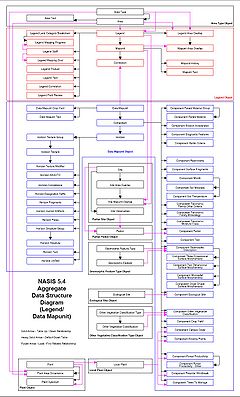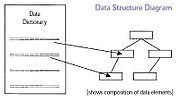
Data structure diagram
Encyclopedia

Data model
A data model in software engineering is an abstract model, that documents and organizes the business data for communication between team members and is used as a plan for developing applications, specifically how data is stored and accessed....
used to describe conceptual data models
Conceptual schema
A conceptual schema or conceptual data model is a map of concepts and their relationships. This describes the semantics of an organization and represents a series of assertions about its nature...
by providing graphical notations which document entities
Entity
An entity is something that has a distinct, separate existence, although it need not be a material existence. In particular, abstractions and legal fictions are usually regarded as entities. In general, there is also no presumption that an entity is animate.An entity could be viewed as a set...
and their relationship
Relational model
The relational model for database management is a database model based on first-order predicate logic, first formulated and proposed in 1969 by Edgar F...
s, and the constraint
Integrity constraints
Integrity constraints are used to ensure accuracy and consistency of data in a relational database. Data integrity is handled in a relational database through the concept of referential integrity...
s that binds them.
The basic graphic elements of DSDs are box
Box
Box describes a variety of containers and receptacles for permanent use as storage, or for temporary use often for transporting contents. The word derives from the Greek πύξος , "box, boxwood"....
es, representing entities, and arrow
Arrow
An arrow is a shafted projectile that is shot with a bow. It predates recorded history and is common to most cultures.An arrow usually consists of a shaft with an arrowhead attached to the front end, with fletchings and a nock at the other.- History:...
s, representing relationships. Data structure diagrams are most useful for documenting complex data entities.
Overview

Diagram
A diagram is a two-dimensional geometric symbolic representation of information according to some visualization technique. Sometimes, the technique uses a three-dimensional visualization which is then projected onto the two-dimensional surface...
type that is used to depict the structure of data
Data
The term data refers to qualitative or quantitative attributes of a variable or set of variables. Data are typically the results of measurements and can be the basis of graphs, images, or observations of a set of variables. Data are often viewed as the lowest level of abstraction from which...
elements in the data dictionary
Data dictionary
A data dictionary, or metadata repository, as defined in the IBM Dictionary of Computing, is a "centralized repository of information about data such as meaning, relationships to other data, origin, usage, and format." The term may have one of several closely related meanings pertaining to...
. The data structure diagram is a graphical alternative to the composition specifications within such data dictionary entries..
Data structure diagrams are an extension of the entity-relationship model
Entity-relationship model
In software engineering, an entity-relationship model is an abstract and conceptual representation of data. Entity-relationship modeling is a database modeling method, used to produce a type of conceptual schema or semantic data model of a system, often a relational database, and its requirements...
(E-R model). In DSDs, attribute
Attribute (computing)
In computing, an attribute is a specification that defines a property of an object, element, or file. It may also refer to or set the specific value for a given instance of such....
s are specified inside the entity boxes rather than outside of them, while relationships are drawn as boxes composed of attributes which specify the constraints that bind entities together. The E-R model, while robust, doesn't provide a way to specify the constraints between relationships, and becomes visually cumbersome when representing entities with several attributes. DSDs differ from the E-R model in that the E-R model focuses on the relationships between different entities, whereas DSDs focus on the relationships of the elements within an entity and enable users to fully see the links and relationships between each entity.
There are several styles for representing data structure diagrams, with the notable difference in the manner of defining cardinality
Cardinality (data modeling)
In data modeling, the cardinality of one data table with respect to another data table is a critical aspect of database design. Relationships between data tables define cardinality when explaining how each table links to another....
. The choices are between arrow heads, inverted arrow heads (crow's feet
Entity-relationship model
In software engineering, an entity-relationship model is an abstract and conceptual representation of data. Entity-relationship modeling is a database modeling method, used to produce a type of conceptual schema or semantic data model of a system, often a relational database, and its requirements...
), or numerical representation of the cardinality.
- Data flow diagramData flow diagramA data flow diagram is a graphical representation of the "flow" of data through an information system, modelling its process aspects. Often they are a preliminary step used to create an overview of the system which can later be elaborated...
- Entity-relationship diagram
- Unified Modeling LanguageUnified Modeling LanguageUnified Modeling Language is a standardized general-purpose modeling language in the field of object-oriented software engineering. The standard is managed, and was created, by the Object Management Group...
Further reading
- Charles W. Bachman. Data structure diagrams. Data Base, 1969, 1(2):4–10.
- Tom DeMarcoTom DeMarcoTom DeMarco is an American software engineer, author, teacher and speaker on software engineering topics. He is known as one of the developers of Structured analysis in the 1980s.- Biography :...
. Structured Analysis and System Specification. ISBN 0-13-854380-1. Prentice Hall. May 11, 1979. - Edward YourdonEdward YourdonEdward Nash Yourdon is an American software engineer, computer consultant, author and lecturer, and pioneer in the software engineering methodology...
. Modern Structured Analysis. ISBN 0-13-598624-9. Prentice Hall. August 1, 1988; now available as the Structured Analysis Wiki.

